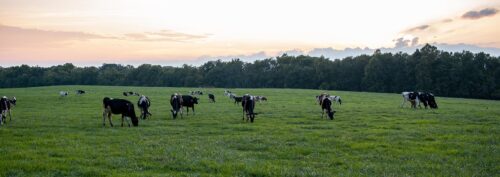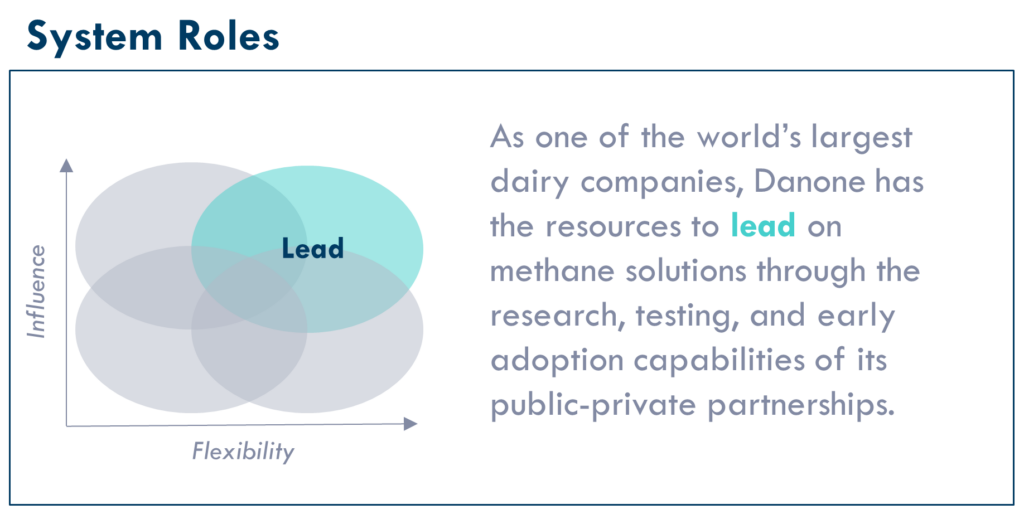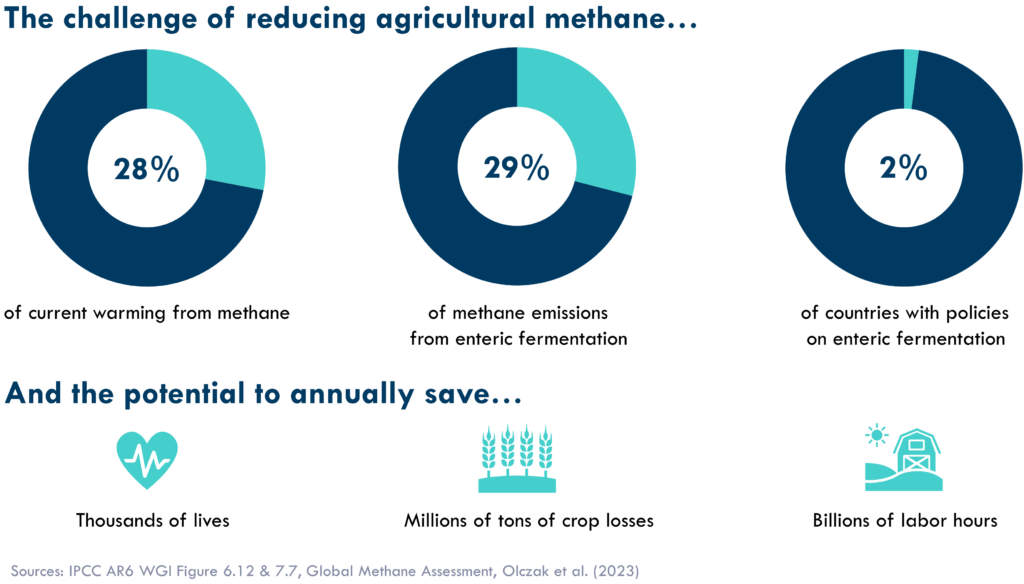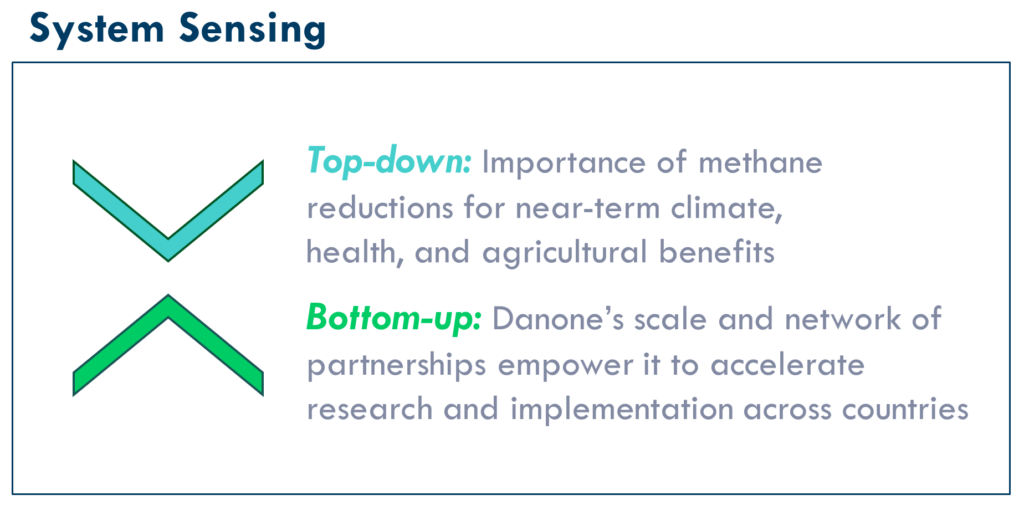
Emergence Strategy in Action: Danone and the Dairy Methane Action Alliance
How public-private partnerships can unlock near-term climate, health, and agricultural benefits from avoided methane emissions.
This is the fourth in a series exploring emergence strategy — a way of integrating systems thinking into corporate climate strategy development. For related case studies, click here.
How could a single company work with 58,000 global farmers to reduce a key climate pollutant in a hard-to-solve sector? This has been a strategic challenge for Danone, one of the world’s largest dairy companies, in making an ambitious pledge to reduce methane emissions from its fresh milk supply.
The answer has required a systems approach to scale solutions across partners in research, policy, market coalitions, supply chains, and farms. With many solutions just beginning the S-curve of market readiness and adoption, Danone has invested in coalitions and networks that can disseminate solutions globally. This will require systems leadership, but could provide major near-term benefits if achieved.
The benefits and challenges of agricultural methane reductions
Methane has driven around 28 percent of human-caused climate change, with almost a third of that from livestock (mostly via enteric fermentation, or animal burps). If livestock methane were a country, it would rank third among all nations contributing to climate change. It is also considered one of the hardest emissions sources to fully address, though studies show that we must reduce agricultural methane to meet global climate goals.
Fortunately, every step that curbs methane has near-term benefits. As a short-lived climate pollutant that also creates ozone pollution, methane has many impacts but is gone in about a decade. If all dairy companies met Danone’s target of 30 percent reductions by 2030, it would decrease near-term warming while saving thousands of lives, millions of tons of crop loss, and billions of labor hours each year — leading to healthier farms and healthier farmers worldwide.
But those benefits have yet to be realized. As of November 2023, only 5 of the 60 largest livestock producers had reported standalone methane emissions, and only 3 had set methane reduction targets. Some others bundle methane into overall climate targets but do not report or set targets separately for methane. This is despite calls from many organizations, including from the UN and US Treasury (as well as Oxford, McKinsey, and many others), for urgent and specific action on methane. Most countries lack plans for agricultural methane as well, and emissions are continuing to rise.
Danone’s pledge and partnerships
Enter Danone and its pledge for 30 percent reductions by 2030 in its fresh milk supply (in line with the Global Methane Pledge). Though demand shifts are not included, key strategies are “improving herd and feed management, reducing manure-related emissions, and developing innovative methane inhibitor solutions.” Given Danone’s global network of farmers, a core challenge will be doing so across the range of smallholder and industrial operations.
Partnerships have been part of that strategy across training, research, and policy work. With NGO and research partners, training initiatives like Farming for Generations have helped reduce methane by 14 percent from 2018 to 2020 (before the timeframe of the pledge). Training in North Africa has already reached more than 10,000 smallholder farmers, which Danone hopes to double over the next three years. Near-term project steps could bring 20 percent of the pledged emissions cuts.
To go further, Danone has invested in “complementary solutions” via research and startup funding. Startup partners such as Symbrosia, Bovaer, and ZELP could reduce some emissions via feed additives and other technologies. Danone was also the first corporate contributor to the Global Methane Hub’s Enteric Fermentation R&D Accelerator, which has surpassed $200 million in funding since its announcement at COP28.
Finally, Danone’s partnership with Environmental Defense Fund (EDF) links this research and financing with policy engagement. This includes advocacy for agricultural methane targets and measurement rules — a critical gap in nations’ climate actions — leading to a positive score in InfluenceMap’s assessment of corporate climate policy involvement. Danone has also joined key business coalition letters via Ceres and others.
Spreading action across the industry
Now, these public-private partnerships seek to spark a broader movement. Danone is one of six major companies in the Dairy Methane Action Alliance, where EDF and Ceres will facilitate methane reporting by July 2024 and methane action plans by December. In tandem, the Sustainable Dairy Partnership has introduced a reporting tool to improve methane transparency. Finally, Danone is one of 20 partners in the First Movers Coalition for Food, where the World Economic Forum will facilitate joint market demand for low-emissions solutions in agriculture.
But the work is just beginning. These alliances only cover a small fraction of dairy emitters so far — and without further improvement, current technical solutions would only solve a minority of emissions. For maximum reductions (and their benefits), many researchers say we also need a broader shift toward healthier consumer diets. Time will tell if these benefits are realized.
The Emergence Strategy Framework
Danone’s efforts map well to the key aspects of emergence strategy, with a focus on collaboration across research, policy, and engagement to advance systems change in a hard-to-solve area.
1. System sensing
Top-down and bottom-up system sensing were both key in scoping Danone’s solution set. As highlighted at the top of Danone’s methane ambition plan: “cutting methane emissions is the most immediate opportunity we have to slow down global warming.” To meet that top-down goal, Danone has outlined a bottom-up plan to build on major partnerships that can accelerate necessary actions — from research funding to farmer training to policy engagement.
2. System solutions
Danone’s focus on solution search and scale-up is aligned with RMI’s five phases approach, which describes how different actions can maximize impact based on the market maturity of solutions. Some efforts still fall under Phase 1 (solution search), like the funding of startup technologies and the Enteric Fermentation R&D Accelerator. Other solutions are ready for adoption by the First Mover Coalition, or widespread dissemination through Danone’s farmer training programs.

3. System roles
As one of the largest dairy companies, Danone has the capacity to lead change by harnessing its partnerships to scale solutions across its 58,000 dairy farmers. Many actions can help others make further reductions, especially if they achieve the potential for better technical solutions, larger market coalitions that demand them, or stronger policy that supports them. These efforts are still in progress, but already show how established companies can use collaboration to drive systems change toward a sustainable future.

Though solutions must be scaled across the industry, the rapid benefits are worth the challenge. Reducing dairy methane would improve local health, regional farms, and the global climate — helping sustain livelihoods for generations to come. The time is now for companies to seize this opportunity.


